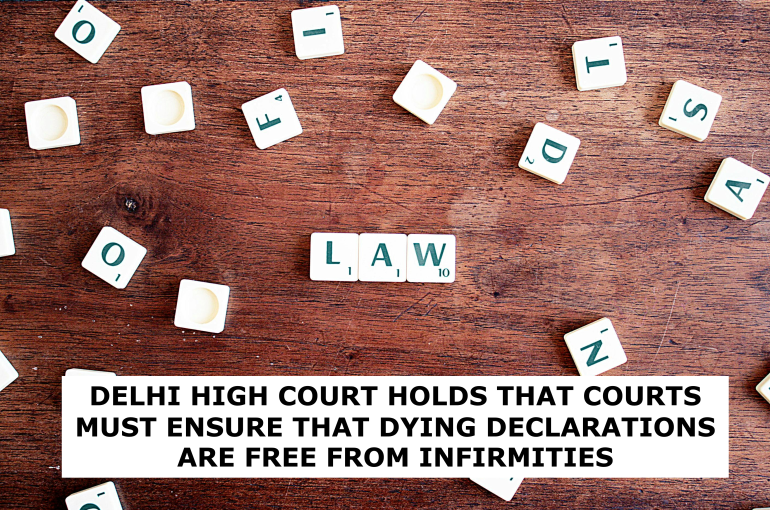DELHI HIGH COURT HOLDS THAT COURTS MUST ENSURE THAT DYING DECLARATIONS ARE FREE FROM INFIRMITIES
A two-Judge Bench of the Delhi High Court, comprising of Justice Suresh Kumar Kait and Justice Manoj Jain, passed a judgement dated 02.07.2024 in Amarjeet vs. State Govt. of NCT of Delhi CRL.A. No. 755/2002, wherein the High Court examined the Dying Declaration of the Deceased. Upon finding no infirmities, the High Court upheld the judgement and order of the Ld. Trial Court in convicting the Appellant-Accused, Amarjeet under Section 302 of the Indian Penal Code 1860 (IPC) (Punishment for murder).
Facts
The Appellant-Accused (Amarjeet) was a tenant living on the first floor of the house (F-389) in Dakshinpuri, Delhi. Sumitra Devi (Deceased), a married woman who was deserted by her husband, used to live on the ground floor.
That on 05.04.1999, the Deceased was found lying in a street in a completely burnt condition. It was later told by Dr. Chander Kanta, a Forensic Medic from Safdarjung Hospital, that 100% superficial and deep burns were found on her whole body during post-mortem.
That the Deceased’s brother, Om Prakash, discovered the Deceased’s body and took her to the Safdarjung Hospital in a van. While retaining her consciousness, she told everyone that Amarjeet poured kerosene oil on her, put her on fire and pushed her down the stairs. The Deceased-Sumitra Devi was declared dead at 2:10 p.m. on the very same day i.e. 05.04.1999.
That an FIR (FIR no. 204/1999) was registered against Amarjeet on the same day. The learned Trial Court framed charges against the Accused under Section 302 IPC and vide Order dated 18.01.2000, Amarjeet was held guilty and was awarded ‘life imprisonment’ with a fine of Rs. 1,000/-.
The Appellant-Accused, Amarjeet, pleaded not guilty since the inception . Hence, aggrieved by the Trial Court Order dated 18.12.2000, the Appellant filed an Appeal before the High Court on the ground that infirmities in the Dying Declaration of the Deceased were not appreciated by the lower Court.
That the learned Counsel appearing for the Appellant submitted that the Dying Declaration, which should inspire confidence, casted doubt over its credibility in this case. He further submitted that the absence of eyewitnesses to corroborate the Dying Declaration made it even harder to rely upon being the sole evidence.
The Prosecution, on the other hand, examined 16 witnesses to prove that the charges levelled against the Appellant were true.
Issue
i) Whether the Dying Declaration of the Deceased is credible enough to consider it a reliable piece of evidence, to bring home the guilt of the Appellant-Accused
Analysis by the Delhi High Court
The Bench relied upon Section 32(1) of the Indian Evidence Act, 1872 (IEA) (Cases in which statement of relevant fact by person who is dead or cannot be found, etc., is relevant) which states the relevance of the statement of a dead person. Further, observations from the earlier judgments of Lakhan vs. State of M.P. (2010) 8 SCC 514 and Shundhakar vs. State of M.P. (2012) 7 SCC 569, were referred to in which the Apex Court observed and declared the importance of the Dying Declaration. The Hon’ble Supreme Court, in the above judgements, observed that a Dying Declaration is enshrined in the legal maxim nemo moriturus praesumitur mentire which means “a man will not meet his Maker with a lie in his mouth”.
The Bench observed that before accepting the Dying Declaration of a person, the Courts are required to ensure that such a statement is not made under any coercion or pressure. It is the Court that has to test that Dying Declaration, if being solely relied upon to convict an accused, is worthy of trust.
Decision by the Delhi High Court
The Bench after careful scrutiny observed that none of the witnesses present were eyewitnesses. However, during the examination-in-chief, it was found that the statements of all the witnesses were similar and that there was no infirmity in the Dying Declaration.
The Bench further took into account that the recovery, of burnt cloth, stove, kerosene oil and hair clip of the Deceased, was done from the first floor of the house and only the Accused resided on the first floor. The Bench found the said evidence enough to corroborate the contentions of the Prosecution that Sumitra Devi went upstairs and was pushed down the stairs by Amarjeet after setting her up on fire.
The Court found no error in the Impugned Order dated 06.10.2001 and the Order of Sentence dated 11.01.2001. While dismissing the Appeal, the Bench declared that the Trial Court had correctly analysed the Dying Declaration and subsequently held that the Dying Declaration in the instant case was fully credible.
Conclusion
Thus, the Appellant-Accused, Amarjeet was directed to surrender within one week to undergo his trial period. The Bench in this matter not only scrutinized and analyzed every minute detail but also reinforced the legal proposition that before accepting the dying declaration of a person, the Courts are required to ensure that such a statement is not made under any coercion or pressure.
SURAJ
INTERN
THE INDIAN LAWYER & ALLIED SERVICES





































Leave a Reply